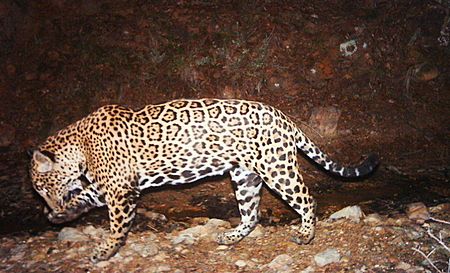El Jefe (jaguar) facts for kids

El Jefe in Arizona, 2013
|
|
| Species | Jaguar |
|---|---|
| Sex | Male |
| Born | Likely Sierra Madre, northwest Mexico |
| Known for | Being one of the few wild jaguars to have been recently sighted in the United States of America |
| Residence | Arizona or Mexico, North America |
El Jefe is an adult, male North American jaguar that was seen in Arizona. He was first recorded in the Whetstone Mountains in November 2011, and was later photographed over several years in the Santa Rita Mountains. From November 2011 to late 2015, El Jefe was the only wild jaguar verified to live in the United States. He has not been seen since 2015 and it is presumed that he returned to Mexico, where the nearest breeding population of jaguars is located. His name - which is Spanish for The Boss - was chosen by students of the Felizardo Valencia Middle School of Tucson, in a contest organized by the non-profit conservation group Center for Biological Diversity in November 2015 and has been used frequently by conservation groups and media. However, several researchers involved in his monitoring prefer to call him simply the Santa Ritas jaguar.
Contents
First sighting
El Jefe was first sighted by cougar hunter and guide Donnie Fenn, along with his 10-year-old daughter, in the Whetstone Mountains on Saturday, 19 November 2011. His hunting dogs chased the animal until he climbed a tree, at which point he took several pictures of him and left to call state wildlife officials. In a news conference organized by the Arizona Game and Fish Department the following Tuesday, Fenn stated that the jaguar, an adult male, climbed down the tree and was chased up a second tree after he had injured some of the dogs in his retreat. The hunter pulled his dogs away, and left the scene. The pictures represent the first evidence of the existence of a wild jaguar in the United States since the death of Macho B in 2009. Several news outlets ran the photos with an article - however a video, said to have been taken at the scene, is not publicly available.
Appearance in the Santa Rita Mountains
On 20 December 2012, through a joint news release the US Fish and Wildlife Service, Arizona Game and Fish Department and the University of Arizona, announced that pictures of a jaguar taken in late November of that year, at the Santa Rita Mountains using camera-traps, belonged to the same individual photographed by Fenn one year earlier. The camera-traps were set by the Jaguar Survey and Monitoring Project an initiative led by the University of Arizona. Individual jaguars can be identified by their unique spot patterns, which allowed researchers to confirm it was the same adult male.
Continued monitoring
Since the emergence of the Santa Rita photographs of El Jefe in 2012, several new pictures and some videos have been released by agencies and groups working in the area, notably by the Wild Cat Research and Conservation Center at the University of Arizona and Conservation CATalyst. A video from Conservation CATalyst with shots from different days gained much attention in the news when it was jointly released with the Center for Biological Diversity.
El Jefe was also monitored by Conservation CATalyst's scat detection dog Mayke. Mayke discovered the first genetically verified jaguar scats in the United States and had over a hundred novel detections of jaguar sign.
Significance and origin
El Jefe is significant as he represented, for four years, the only verified jaguar currently living in the United States, where they once were distributed throughout the southwest. Before being found it was believed that the species had been completely extirpated in the United States. Historically, the jaguar was recorded in far western Texas, and the northern parts of Arizona and New Mexico. However, since the 1940s, the jaguar has been limited to the southern parts of these states. In 2010 the US Fish and Wildlife Service was successfully sued by Defenders of Wildlife to produce a Species Recovery Plan and designate Critical Habitat for jaguars, it has since drafted an area that includes the Santa Rita mountains as the Critical habitat for the species recovery in the United States.
The northernmost breeding population of jaguars, from where El Jefe most likely came, was identified by Brown and López González in eastern Sonora, Mexico and named the Huásabas-Sahuaripa population, after two of the municipalities over which it extends. This population has been the target of several conservation efforts, most notably the creation of the Northern Jaguar Reserve, a private wildlife sanctuary first established in 2003 by Naturalia, a Mexican non-profit conservation organization and Northern Jaguar Project and since expanded from its original 4,000 hectares (40 square kilometers) to 24,400 hectares (244 square kilometers) in 2015.
As part of its efforts to determine critical habitat for the species and to understand how jaguars from this population have been reaching the United States, the US Fish and Wildlife Service commissioned the Wildlife Conservation Society to develop a connectivity model, that could inform which areas are likely to serve as wildlife corridors linking breeding populations of jaguars in Mexico to known locations of recent sightings in the United States. The report included a series of maps that identify the areas most likely to be used by jaguars along the western states of Mexico, and reaching into Arizona. It further identifies intersections between these corridors and major highways, as a first step in addressing the challenges any females may face trying to reach Arizona. The establishment of a breeding population of jaguars in the U.S. requires that at least one breeding female uses the U.S. as part of its territory, and is regarded as a milestone in species recovery.
See also
 In Spanish: El Jefe (jaguar) para niños
In Spanish: El Jefe (jaguar) para niños

